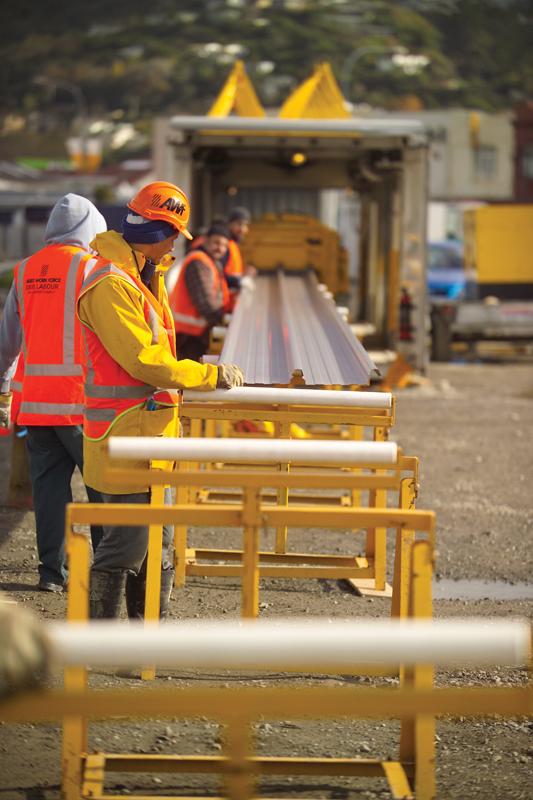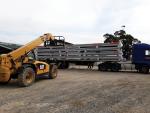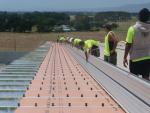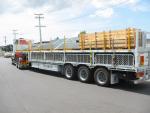Long run vs fixed length short sheets

Once upon a time, or in fact for most of the history of sheet metal roof and wall cladding, the stuff was not “long-run” at all. Metal roofing has of course been around for a very long time. The Romans used copper and lead sheet as roofing materials and copper roofing as shingles or seamed panels that are a familiar sight in many mediaeval European cities. Some roofs were made of iron or zinc.
What we now recognise as metal roofing took off in the UK for sheds and factories and for housing mostly in the Colonies of the British Empire rather than the home country in spite of being invented there.
What allowed this to happen was the invention of steel (stronger and harder than iron) which allowed the forming of thin sheets. This however was very prone to corrosion by any sort of marine atmosphere resulting in rather short life in most places. The next important invention was the use of a thin coating of zinc to protect the steel by preferential corrosion - the zinc corrodes away very slowly, compared to the base steel, until it is all gone the steel remains uncorroded). Then it was realised that while the thin sheets of coated metal might have been durable they were very weak and not able to span any useful length. An anonymous person in a flash of brilliance (there is a possibly apocryphal story about him seeing a creased sheet spanning a gap) came up with the idea that corrugating the sheet would allow it to span a significantly greater length between supports, and not laid on timber as was all sheet roofing up to then. And so was borne “wrinkly tin” - not really wrinkly and definitely not tin.
The corrugating was done by putting sheets of steel into a sort of mangle with corrugations in it. The galvanising was done by dipping the corrugated sheet into a bath of molten zinc and allowing the excess zinc to drain off, which meant the coating thickness was more or less self determined. These processes had two natural outcomes - the maximum length of the sheet was determined by the maximum width that could be corrugated evenly; and the zinc coating tended to be heavier at the bottom of the sheet as the molten zinc ran off. For what is really most of the history of sheet steel roofing this was the product - corrugated “iron” - in sheets of 10 feet (3m) long and somewhere around 600 g/m² zinc coating. This hit the world market around 1830 and was exported down under from the UK until the Lysaght factory was built in Sydney and Australian product was used there and in New Zealand with fairly minimal changes until the early 1950s.
For all this time the results were that we had 3m maximum length sheets - which can still be seen on many houses in New Zealand, and with uneven zinc coating weight which could lead to bands of rusting on the thinner areas while the rest of the roof was fine. Stuart Thomson’s book shows a roof well over 100 years old, rusty, but still in one piece, somewhere in coastal Otago.
Long run development
Over the next 60 years huge changes in technology created the large range of “longrun” cladding products we have available today.
- Continuous rollforming instead of sheet corrugating, allowing sheets of any length, and so the ability to make specific length minimum-waste house-lots;
- Continuous galvanising with more even (and thinner) coating weights;
- New profiles leading to today’s main families of corrugate (still!) now in more shapes; trapezoidal shallow and deep; and tray roofing ;
- Higher strength steel allowing thinner (and cheaper) product - now in NZ 0.40 vs 0.55 mm;
- Pre-painted product, from the 1980s;
- Staged manufacture of coated steel in New Zealand; and
- Different metallic coatings to just plain zinc.
So we now have available protected and possibly pre-painted steel cladding in infinitely long sheets (or at least as long as you can design a roof for) Well, not quite. The theoretical ability to make sheets of any length does have some limitations.
Making it
In theory the maximum length of sheet that can be roll-formed is the length in one coil of steel. Depending on the profile, the thickness and the width a 5 tonne coil would make around 1 km of roll formed sheet. Not likely to happen. So what are the restrictions?
How long is the available space (including the area outside the building after the exit of the roll former? What is the weight capacity of the carrying/moving system? What is the ability to assemble into packs and lift onto transport? Can the product be roll-formed onto a truck bed and if so how long can this be?
In practice, unless the factory is very small, other external limitations will be determining the maximum length of sheet made for any particular application.
Transporting it
So, having made it, how will it get to its destination. According to NZTA the maximum allowable length of a truck is 12.6 m or 11.5 m if towing a trailer. Maximum for a truck and trailer is 23 m. Weight is not likely to be a limitation. So assuming the sheets go behind the cab the maximum is about 10m plus 4m overhang. So this looks like a limitation. There is however a get-around that can be and is used.
Rollforming on site/onto the roof
Clearly the limit to length at this point is how to get it to site (and onto the roof as a separate issue.) In the onsite process the rollformer is taken to the site and either left on the ground with a space beyond it at least equal to the length to be made, or left on the transporting truck. The product is roll formed and then lifted onto the roof usually by crane. A variation to this process is for the rollformer to be tilted to the same pitch as the roof and the product roll-formed directly onto the roof. Both of these processes require a day with minimum wind. A 50 m sheet of steel is both heavy and quite aerodynamic and creates its own difficulties.
Handling it
If the product arrives in a truck it will be in packs strapped up to be capable of being lifted by a crane or the truck’s own Hiab. The pack(s) will be placed on the ground, opened and the individual sheets again lifted onto the roof. The longer the sheets the more hazardous this is and a calm day is required for safe installation without damage to the sheets.
Installing it
This is one process where the length doesn’t make much difference provided the sheets are not wind blown, which can create difficulties with any roofing.
Problems caused by length of the roof in situ
Describing these issues is the main point of this article; the above is really an introduction to some length problems which are handled in various ways by different manufacturers/suppliers and installers. The issues are highlighted in Section 7.3. of the COP Here we will expand on these factors. Most of them are to do with expansion and contraction and its side-effects.
Residential and Industrial roofing have a number of differences - length is typically longer (sometimes much longer) for commercial (warehouses) or industrial (factories) buildings than for residential buildings although these may overlap. There are a number of other differences which affect behaviour on the roof.
Expansion.
All metal cladding and flashings are subject to expansion and contraction caused by changes in temperature, and the design of metal roofs needs to allow for this movement.
The COP provides an example of unimpeded expansion of a 30 m length of roofing as 22 mm, but a number of factors in the installation determine how much of this occurs on actual installations. The ribs of metal trapezoidal or corrugated roof and wall cladding absorb expansion across the width of the sheets, and the longitudinal expansion is taken up by the bowing of the sheet between fastened supports. The further apart the purlins are the more expansion between them is possible and the greater fastener spacing laterally there is also allows more bowing between them. Bending of the fasteners can also absorb some movement before damaging the surrounding sheet.
The temperature which the cladding reaches and the factors which determine this and how the resulting need to expand can be dealt with are covered in 7.3.2.
Discussing these and seeing how they are affected by the type of building/roof cladding
Material.
Aluminium will expand about twice as much as steel, lead almost three times as much and other metals in this range, so an aluminium roof will need greater provision for expansion than steel.
Colour/Gloss
Regardless of all the other factors, darker colours will absorb more heat than lighter colours and less glossy surfaces absorb more heat than shiny ones. So a dark matt roof will absorb significantly more heat than a shiny light roof (or unpainted Zincalume ®).The use of “cool” pigments may ameliorate this effect to some extent.
Insulation and under-roof ventilation
The main difference here between a typical residential and typical industrial/commercial building is that the residential roof will have a closed space underneath it and the industrial building will have an open space underneath it (factory or warehouse) with air movement occurring.
The extremes are a factory with an uninsulated roof or foil immediately under the roof with no sealed air gap and a house with a shallow pitch skillion roof with minimal or no ventilation.
Where the roof cladding has insulation immediately below the roof material such as in a skillion roof or a warm roof, heat absorbed by the roofing cannot be radiated into the building, nor is it cooled by ventilation underneath it.
Fastening with what into what
Once upon a time all roofs were corrugate with small rib height and fastened with nails into timber purlins. Longitudinal expansion of the roof could only bend the nail slightly between the timber and the ridge, but the nail itself was quite thin and flexible. House roofs today still have typically low profile roofing but now we use screws or much thicker nails. Pan fixing of course is the ultimate no-movement fixing.
Today we can use in industrial buildings trapezoidal profiles with rib height more than double that of corrugate and C or Z section purlins which can flex as the roof expands - but screws which are very much less flexible than the old nails and in fact will break or bend permanently rather than move with the roof in both directions.
Time of installation
At some times of the year when the temperature changes greatly during the day sections fixed in early morning or in the shade will show greater expansion effects that those fixed in full sun or after midday.
Size of the building
While there is a continuum of roof lengths from small sheds to giant factories there tends to be a natural break between houses which do not normally have lengths much above those shown in section 7.3.2 and larger industrial buildings which may have roof lengths in excess of 50 metres.
What happens
We can see there are a number of factors which can increase or decrease expansion potential and other contradictory factors which can absorb expansion. However, at some point the expansion overcomes the ability of these factors to minimise the effect and we have thermal expansion failure.
This is normally manifested as fastener failure - breaking or permanent distortion, and/or tearing, buckling or breaking of the cladding. This can damage the roof to the point where it requires replacement. The other less destructive but potentially serious effect of expansion is roof noise, which can be heard in a range of ways, from occasional creaking to sleep-depriving banging. Different times of day for fixing different roof sections may result in different levels of noise in different areas.
Dealing with expansion.
It is necessary to understand that the roof cladding whatever it is made of and how it is fixed will expand and contract under normal diurnal temperature changes. The factors discussed above may be additive so that expansion problems occur at quite short lengths, or they may offset each other so that greater lengths can be achieved with no obvious issues. The tables in 7.3.2S and B (COP) illustrate the sort of lengths that can be used when more or less favourable circumstances are in play. The steps to take to reduce the probability of damage at the lengths shown are also listed -
Oversize holes and washers in the overlength part; Slots can be used but need to be sealed properly; Step flashing as shown; and The ultimate solution for very long roofs is to use secret or clip fixing. This is not without it’s own problems, but does allow expansion and contraction in a reasonably unconstrained way.
So, in expansion of metal roofing we have an inevitable outcome from using metal as the base material. As we have made roofing in different shapes and sizes and finishes and fixed with different fasteners - all huge changes occurring in the last 50-60 years - we have learned to accommodate this outcome in a variety of ways so that damage caused by expansion only occurs very rarely, and is just another feature of our great roofing material we can manage without difficulty.



